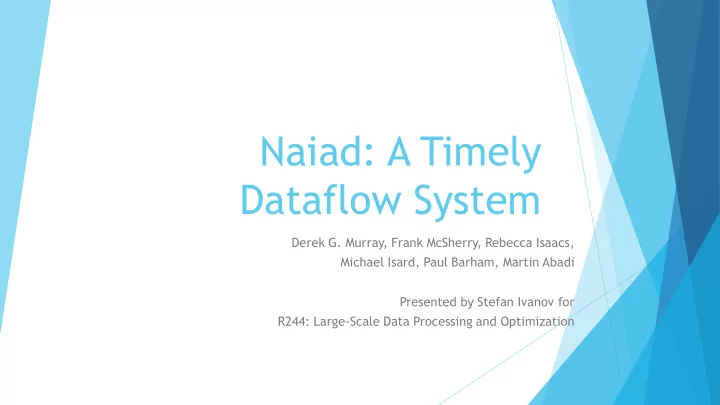

Naiad: A Timely Dataflow System Derek G. Murray, Frank McSherry, Rebecca Isaacs, Michael Isard, Paul Barham, Martin Abadi Presented by Stefan Ivanov for R244: Large-Scale Data Processing and Optimization
Summary The Context – Overall ideas The Problem – Main contributions Opinions – How good is the paper? Conclusion
The Context
Distributed computation model Source: [4]
Motivation for Naiad Data processing tasks are quite varied in terms of workload Architectural difficulty combining the various processing approaches Source: [1]
What is Naiad? A low-latency and high-throughput system for executing data parallel, cyclic dataflow programs. A note on naming An application written for Dryad is modeled as a directed acyclic graph (DAG) and Dryad is the "tree nymph" in Greek mythology. Naiad is a stream processing platform and Naiad is the "stream nymph" in Greek mythology.\
Authors: Who, where, when? Derek G. Murray, Frank McSherry, Rebecca Isaacs, Michael Isard, Paul Barham, Martin Abadi → Worked for Microsoft Research Silicon Valley while writing the paper → Everyone (but Frank McSherry) moved to Google Further research on timely data flow → mostly refinements on their ideas Frank McSherry → also continued research on dataflow computations
Environment: Other frameworks Batch processing: Dryad MapReduce Spark Stream processing: Storm MillWheel Graph processing: Pregel GraphLab Giraffee
Environment: Authors’ previous work Composable Incremental and Iterative Data-Parallel Computation with Naiad [2] Verification of mathematical model and introduction to partially order relations (found in the discussed paper) Precursor paper, developed from a focus on differential data flow to a more general framework
The Problem
Arbitrary Graph Execution Model Structured loops Stateful dataflow Notifications Source: [1]
Generalization for dataflow programming Runtime, graph construction and the timely dataflow modules are completely separate. Enables, a “mix -a- match” concentrated Source: [1]
Timely dataflow: Timestamps Partial order based on lexicographical comparison Optimization opportunities due to formal verification of out the progress tracking code [3] Source: [1]
Timely dataflow: Loop Contexts Necessary to impose a partial order of the notes Fundamental for any iterative algorithm Could-result-in metric Source
Timely dataflow: Callback model Based on event passing (callbacks etc.) Interface methods v.ONRECV(e : Edge, m : Message, t : Timestamp)\ v.ONNOTIFY(t : Timestamp) this.SENDBY(e : Edge, m : Message, t : Timestamp) this.NOTIFYAT(t : Timestamp).
Timely dataflow: Callback model Source: [4]
Timely dataflow: Callback model Source: [4]
Distributed implementation: Runtime Naiad “Core” → about 22700 lines of code Controls the “physical graph” (what runs where) Use of intrinsic for common operations with known semantics (i.e. join, select, count) Workers communicate through message queues
Distributed MapReduce Implementation implementation: Low- level API The C# interface discussed before Relatively simple to use, yet verbose and error prone High performance applications can drop to this level if necessary Source: [1]
Distributed implementation: High-level programming models Typical usage of Naiad is through other computational models and libraries build upon the low-level API
Mathematical formalization and optimizations In a separate paper [3] “Formal analysis of a distributed algorithm for tracking progress. In Proceedings of the IFIP Joint International Conference on Formal Techniques for Distributed Systems, June 2013” The previous Naiad paper [2] also contains mathematical formalism but for differential dataflow
Results: Microbenchmark results Source: [1]
Results: Real world applications Source: [1]
Fault tolerance Not a primary concern of Naiad Implemented through a Checkpoint and Restore mechanic Using continuous checkpoints reduces performance significantly
Opinions
Agreement and disagreements Agreements Disagreements The API is cleaner and Choice of implementation more extensible language Generic API allowing for Little focus on optimizations various parallel models among subset of workers Flexible execution model
Strengths and weaknesses Strengths Weaknesses Easy to implement a (Personal opinion) Not relatively performant quite trivial to set up distributed system in no High memory usage which time limits general Consistency algorithms applicability and the communication Naiad as a system is not as protocol is verified popular as I would expect explicitly
Key takeaways Timely dataflow is a unique model with convenient properties enabling high throughput and low latency Decoupling high-level programming model from the implementation detail of the runtime Providing an efficient base for complex systems enables requiring batch, stream and graph processing techniques
Impact Best paper of Symposium on Operating Systems Principles (SOSP) 2013 More than 100 citations (after a quick research) Affected distributed data flow programming systems Timely dataflow programming is still in development
References [1] Murray, McSherry, et al., Naiad: A Timely Dataflow System [2] McSherry, Isaacs, et al., Composable Incremental and Iterative Data- Parallel Computation with Naiad [3] Abadi, McSherry, et al., Formal Analysis of a Distributed Algorithm for Tracking Progress [4] Naiad: A Timely Dataflow System: https://www.youtube.com/watch?v=yyhMI9r0A9E
Q&A
Thank you for your attention
Recommend
More recommend